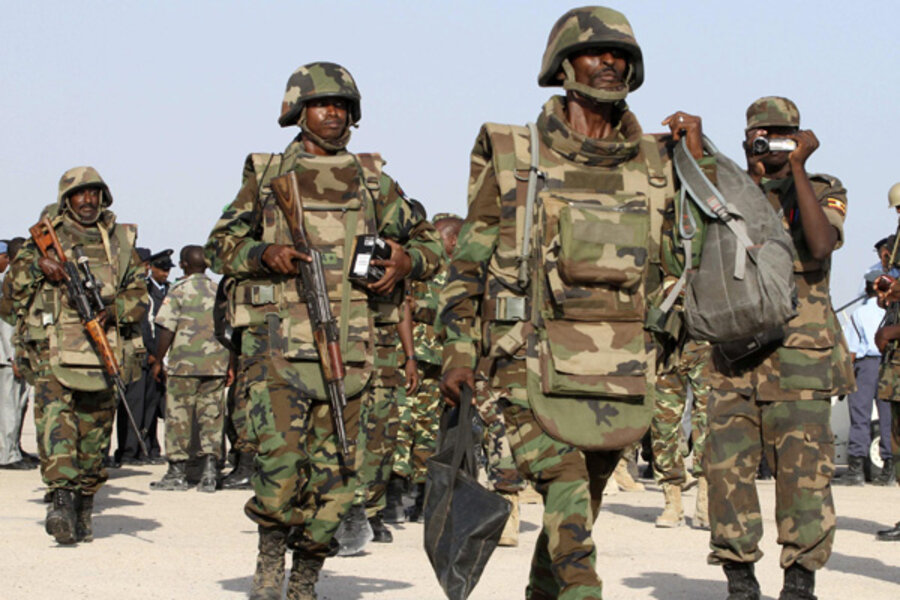Somalia's Al Shabab Islamists are on the run
Loading...
With more and more African Union countries sending peacekeeping troops to Somalia, and with the militant group Al Shabab clearly on the retreat, it might appear that Somalia’s future is finally starting to look bright.
Bright is too strong a word, of course. Much of Somalia remains in the grip of a famine. Its coastline is a haven for pirates, smugglers, and criminal gangs. Military incursions by Kenya and Ethiopia will almost inevitably take a heavy toll among civilians as they fight groups like Al Shabab. And the Somali government, responsible for creating a stable, workable society after the militant groups are defeated, seems barely able to carry on a conversation with itself without getting into a fistfight.
Yet after years of neglect, Somalia is finally getting international attention, and the flurry of diplomatic and military activities does provide some hope that Somalia may finally pull itself out of a 20-year period of civil war, anarchy, and dysfunction.
The greatest activity appears to be on the military front.
In the east, Ethiopian troops have taken the central Somali town of Beledweyne, a key transport hub on the road to Mogadishu. Residents in the villages outside of Beledweyne say that Al-Shabab fighters have been trying to recruit young men to join them and halt the Ethiopian advance, but with one of the strongest armies on the continent, Ethiopia is unlikely to face much of a challenge if it intends to carry on toward Mogadishu.
Ethiopia has been this way before, occupying Somalia briefly, from July 2006 to August 2008, after overthrowing the Islamic Courts Union, a coalition of religious parties intent on imposing shariah law in Somalia.
In the south, the Kenyan Army seems to be on the move once more – they launched their incursion into Somalia in mid-October but have been slowed down by heavy rains – and appear to be moving in on the Shabab-held town of Afmadow. Afmadow is the largest town between the Kenyan Army and the Shabab headquarters in Kismayo, a large southern trading port where Shabab derives much of its income by controlling the smuggling trade.
How to find a solution in the middle of a fist fight?
But in Mogadishu itself, as AU peacekeepers continue to arrive – the latest being 200 troops from tiny Djibouti – the fragile Transitional Federal Government that the AU intends to support is busy fighting itself over who is in charge.
On Wednesday, a fistfight broke out between parliamentarians supporting and opposing the parliament speaker, Sharif Hassan. Somali President Sharif Sheikh Ahmed supports Sharif Hassan, but his supporters are in the minority and were forced to flee parliament by the opposition, who apparently were using tables and chairs as weapons. Four parliamentarians were reportedly hospitalized, according to Garowe news agency. It was the fourth brawl in parliament since December.
A government divided against itself at war time is never a good thing. Yet Somalia’s neighbors seem determined to create an overall African Union Mission in Somalia (AMISOM) peacekeeping force of up to 17,700 fighters within the next few months, both to support the Somali government, and to expel what they see as a common terrorist threat of Al Shabab.
Rooting out militant groups may be seen as crucial to regional security by Somalia’s neighbors, but finding a political solution for Somalia is also seen as the only way to end what is most certainly the world’s worst humanitarian disaster.
At present, more than 1.85 million Somalis have received food assistance from the UN’s World Food Program, and at least an equal number of Somalis are thought to be in need during what is the worst famine in more than 20 years.
An additional 500,000 Somalis receive food assistance in Kenya’s Dadaab refugee camps. War prevents many of these people from remaining at home, planting crops, raising livestock, and breaking themselves from dependence on foreign aid.
Adding to the burden
The taint of terrorism – Al Shabab claims to have links with Al Qaeda – has added an even bigger burden.
US-based banks have been forced to halt the practice of sending remittances from diaspora Somalis back home to their relatives in Somalia, out of fear that some of that money may end up in the hands of Al Shabab. The problem, US law enforcement agencies say, is that the method for sending money – a traditional money transfer system called “hawala” – is difficult to monitor, and is often used by terror groups. Aid groups argue that stopping the flow of remittances – money donations sent by expatriate Somalis to their relatives – during a humanitarian crisis will hit civilians the hardest.
Oxfam America’s Shannon Scribner said in a statement that the US government should allow remittances to continue.
"It is estimated that $100m in remittances goes to Somalia from the US every year. This is the worst time for this service to stop. Any gaps with remittance flows in the middle of the famine could be disastrous," said Scribner.
Ken Menkhaus, a Somalia expert and associate professor at Davidson College, says the famine in Somalia would have been “much worse” if Somali families living abroad didn’t have the ability to send home money to keep relatives alive.
“The 2011 famine in Somalia would have been far worse had it not been for the extraordinary mobilization of remittances sent by the Somali Diaspora to both their extended families and to local charities -- and all those remittances were sent through the hawala system,” Mr. Menkhaus said in the joint statement with Oxfam.
It's a complicated mess, to be sure, but 20 years of civil war in Somalia should be enough evidence that ignoring the problem doesn't make it go away.





